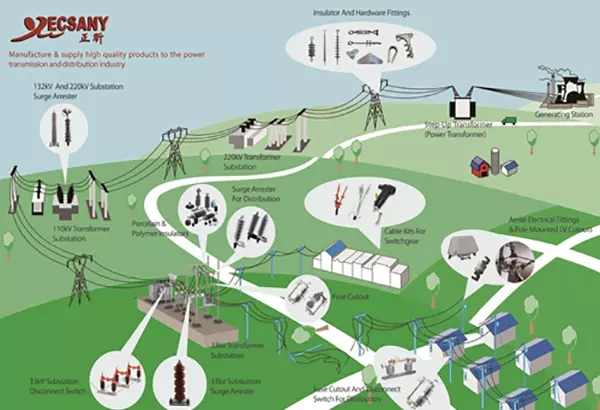Introduction of Power Transmission, Distribution and Power Supply
2022-08-11
2020-11-17
Power Transmission
Mainly refers to various hub substations and intermediate substations.
Hub substation: It is the substation that connects the high voltage and medium voltage of the power system, gathers multiple power sources, and has a voltage level of 330-500KV. If there is a power failure, it will cause the system to be disconnected or even paralyzed.
Intermediate substation: Mainly to exchange electric energy, or to segment long-distance transmission lines, generally gather 2-3 power sources, with a voltage level of 220-330KV, and at the same time reduce the voltage to supply local electricity, that is, the main power grid play the role of an intermediate link. If there is a power outage, it will cause the regional power grid to be disconnected.
Transmission line equipment composition
Compared with the substation equipment, the transmission line is relatively simple and the structure is relatively simple. According to the equipment condition maintenance regulations, the transmission line is mainly divided into seven units and one environment;
Seven units are towers, ground wires, insulators, fittings, tower foundations, grounding devices, and auxiliary facilities.
One environment refers to a channel environment.

Power Distribution
Mainly refers to various regional substations. They are substations that mainly supply power to regional users. They are the main substations of a region or city. The voltage level is generally 110-220KV. After a power outage, they only affect the power supply in the region.
Power distribution is divided into AC power supply mode and DC power supply mode according to the power supply mode:
AC power supply mode:
Three-phase three-wire system: divided into delta connection (for high-voltage power distribution, three-phase 220V motor and lighting) and star connection (for high-voltage power distribution, three-phase 380V motor).
Three-phase four-wire system: used for 380, 220V low-voltage power and lighting mixed power distribution.
Three-phase, two-wire and one-ground system: mostly used for rural power distribution.
Three-phase single-wire system: often used in electric railway traction power supply.
Single-phase two-wire system: Mainly supply electricity for residents.
DC power supply mode:
Two-wire system: used for power supply for urban trolleybuses, subway locomotives, and mine traction locomotives.
Three-wire system: supply electricity for power plants, substations, power distribution stations and secondary equipment, electrolysis and electroplating.
Main power equipment for power distribution:
High voltage fuse cutout, Vacuum circuit breaker, SF6 circuit breaker, High voltage isolating switch, High voltage load switch, Lightning arrester, Voltage transformer, Current transformer, Low voltage fuse, etc.
Power Supply
Mainly refers to various terminal substations. They are at the terminal of the transmission line and directly supply power to users after step-down, and the voltage level is generally below 110KV. If there is a power failure, only users will suffer.




